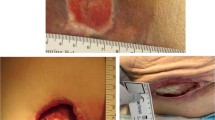Abstract
The decubitus spectrum extends from an innocent-appearing reddened cutaneous area to a catastrophic ulcer that involves destruction of skin, subcutaneous tissue, muscle, and bone [1]. Whether the lesion is referred to as a decubitus ulcer, pressure sore, bedsore, or even euphemistically as a torsion stress injury, it is evidence that a significant interruption in the integrity of the skin has occurred [2].
Access this chapter
Tax calculation will be finalised at checkout
Purchases are for personal use only
Preview
Unable to display preview. Download preview PDF.
Similar content being viewed by others
References
Yarkony GM (1994) Pressure ulcers: a review. Arch Phys Med Rehabil 75:908–917
Parish LC, Witkowski JA, Millikan LE (1988) Cutaneous torsion stress alias the decubitus ulcer: a felony. Int J Dermatol 27:375–376
Witkowski JA, Parish LC (1992) Diagnosis and management of pressure ulcers. In: Moschella S, Hurley HJ (eds) Dermatology. Saunders, Philadelphia, pp 2237–2250
Parish LC, Witkowski JA (1989) The infected decubitus ulcer. Int J Dermatol 28:643–647
Parish LC, Witkowski JA (1994) Chronic wounds: myths about decubitus ulcers. Int J Dermatol 33:623–624
Witkowski JA, Parish LC (1993) Skin failure and the pressure ulcer. Decubitus 6(5):4
Mawson AR, Siddiqui FH, Biundo JJ Jr (1993) Enhancing host resistance to pressure ulcers: a new approach to prevention. Prev Med 22:433–450
Ditunno JF Jr, Formal CS (1994) Chronic spinal cord injury. N Engl J Med 330:550–556
De Conno F, Ventafridda V, Saita L (1991) Skin problems in advanced and terminal cancer patients. J Pain Symptom Manage 6:247–256
Spoelhof GD, Ide K (1993) Pressure ulcers in nursing home patients. Am Fam Physician 47:1207–1215
Steward TP, Magnano S J (1988) Burns or pressure ulcers in the surgical patient? Decubitus 1:36–40
Papantonio CT, Wallop JM, Kolodner KB (1994) Sacral ulcers following cardiac surgery: incidence and risks. Adv Wound Care 7:24–36
Kemp MG, Keithley JK, Smith DW, Morreal B (1990) Factors that contribute to pressure ulcer in surgical patients. Res Nursing Health 13:293–301
Calvin M (1995) Thermal burns in the elderly: classification and pathophysiology. J Geriatr Dermatol 3:149–157
Versluysen M (1986) How elderly patients with femoral fracture develop pressure ulcer in hospital. BMJ 292:1311–1313
Teasell R, Dittmer DK (1993) Complications of immobilization and bed rest. Part 2: other complications. Can Fam Physician 39:1440–1442, 1445–1446
Parish LC, Witkowski JA (1980) Clinitron therapy and the decubitus ulcer: preliminary dermatologic studies. Int J Dermatol 19:517–518
Pase MN (1994) Pressure relief devices, risk factors, and development of pressure ulcers in elderly patients with limited mobility. Adv Wound Care 7:38–42
Parish LC, Witkowksi JA, Crissey JT (1989) Unusual aspects of the decubitus ulcer. Decubitus 1:22–24
Arndt KA, Mihm MC, Parrish JA (1973) Bullae: a cutaneous sign of a variety of neurologic diseases. J Invest Dermatol 60:312–320
Parish LC, Witkowski JA (1990) Leg ulcers due to miscellaneous causes. Clin Dermatol 8(3,4):150–156
Lyell A (1979) Cutaneous artifactual disease. J Am Acad Dermatol 1:391–407
Grotting JC, Bunkis J, Vasconzez LO (1987) Pressure sore carcinoma. Ann Plast Surg 18:527–532
Shibuya H, Terashi H, Kurata S et al. (1994) Gas gangrene following sacral pressure sores. J Dermatol 21:518–523
Muburak SJ, Owen CA, Hargens AR et al. (1978) Acute compartment syndromes: diagnosis and treatment with the aid of the wick catheter. J Bone Joint Surg 60:1091–1095
Darouiche RO, Landon GC, Klima M, Musher DM, Markowski J (1994) Osteomyelitis associated with pressure sores (see comments). Arch Intern Med 154:753–758
Author information
Authors and Affiliations
Editor information
Editors and Affiliations
Rights and permissions
Copyright information
© 1997 Springer-Verlag Berlin Heidelberg
About this chapter
Cite this chapter
Parish, L.C., Witkowski, J.A., Crissey, J.T. (1997). Clinical Picture. In: Parish, L.C., Witkowski, J.A., Crissey, J.T. (eds) The Decubitus Ulcer in Clinical Practice. Springer, Berlin, Heidelberg. https://doi.org/10.1007/978-3-642-60509-3_6
Download citation
DOI: https://doi.org/10.1007/978-3-642-60509-3_6
Publisher Name: Springer, Berlin, Heidelberg
Print ISBN: 978-3-642-64436-8
Online ISBN: 978-3-642-60509-3
eBook Packages: Springer Book Archive




